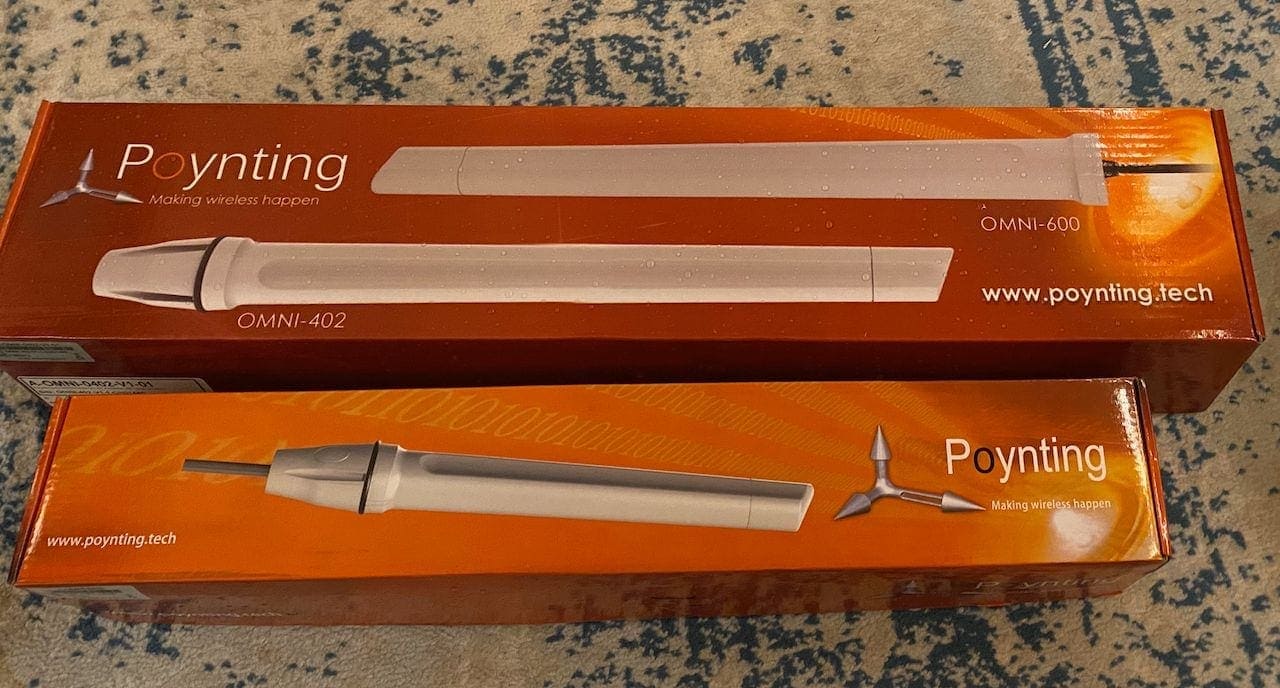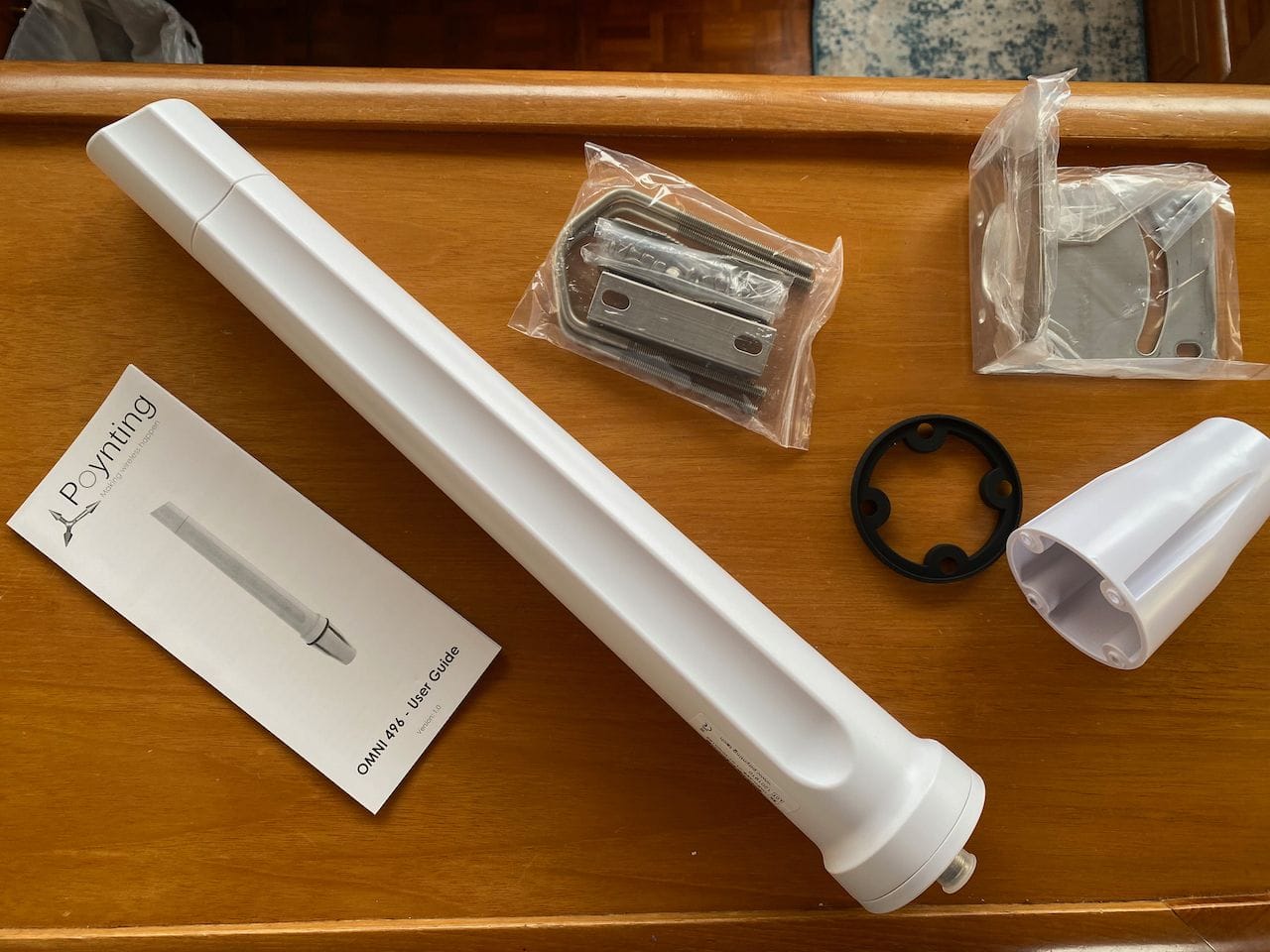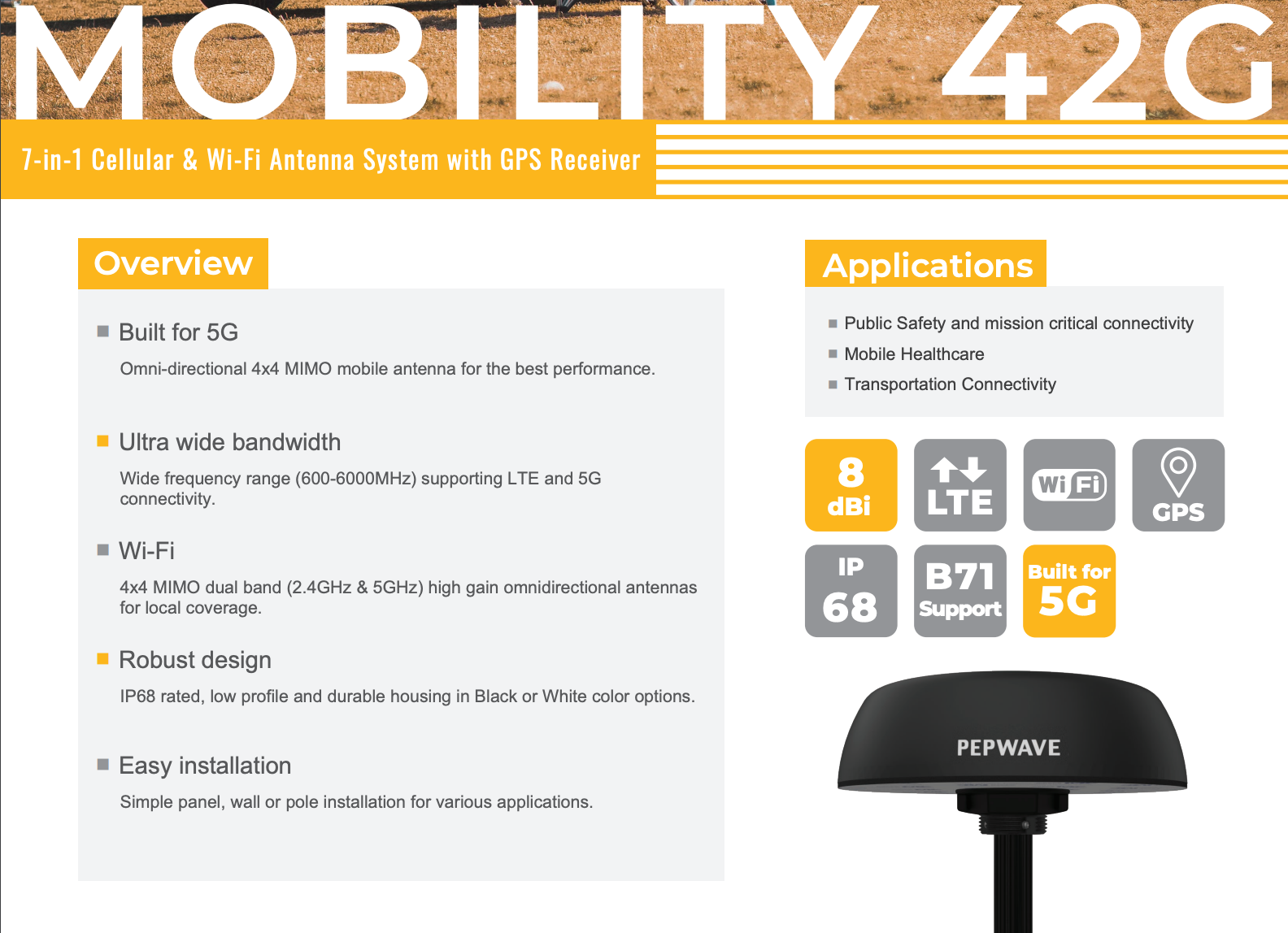Peplink has not had a great antenna lineup for the last few years. Their older antennas, specifically for cellular, weren't really compelling, and none were fully marine friendly. The good news is that both Peplink and Poynting have new antennas for the marine world that look very attractive.
My go-to antenna vendor has been Poynting for about 3 years, and their OMNI series of antennas are well built, marine ready, and perform extremely well. You can see reviews on the OMNI-400 and 402 below, which are specifically for cellular, as well as the OMNI-496, which is designed for WiFi.


While Poynting antennas have been great, their performance in the lower bands has been less than ideal.
Testing Background
I have talked about how I test in the past, but at the high level here are some of the main bullet points with my approach:
- Real world - I try to use the antennas in as many real-world scenarios as possible which includes in marinas, at anchor, and varying signal levels. I also don't just test them, I use them all day long for work, relaxation, etc.
- Duration - testing for a week doesn't do it for me. I want to see these things work for a month or two and get a true feel for their performance in as many conditions as possible.
- Comparison - when testing, I usually have at least 2 other antennas that I test against that are known quantities. This allows me to compare performance across multiple types of antennas. I also use all three major US carriers and cycle through the antennas, sometimes testing them simultaneously on the same carrier with differing antennas, to get as close to identical conditions as possible.
- Equipment - I try to use a mix of old and new routers to see how things perform.
Performance Defined
I have a very specific, marine-focused definition of what I consider to be a good marine antenna. This is an area that I get a lot of questions about and it is important to understand.
Without jumping into a deep discussion about antenna performance, elements, and many other things, the bottom line is that most of the mobile routers and marine antennas are tuned and designed to perform well all the time whether that be in a metro area or in the middle of nowhere.
Think of them like all-weather tires. They will work in the summer well, deal with water and hydroplaning, and have decent performance in the snow. They won’t perform like racing slicks on hot pavement, nor will they let you go jump into 2’ snowdrifts.
When I talk about the performance of marine antennas, I’m specifically focused on always being connected with good connectivity and decent bandwidth all of the time.
Peplink Mobility Antennas

Peplink rolled out a series of "puck" style antennas earlier this year which I wasn't really that enthused about. My experience with these types of antennas on the water has been mediocre at best, and terrible most of the time. Shoving 2-4 different antenna elements in something the size of a coffee cup doesn't bode well for picking up cellular signals in remote locations.
In addition, puck-style antennas are very flat, so if you are rotating or moving side to side at anchor or underway, an entire "side" of the antenna is pointing directly at the water, and pretty useless.
The Peplink Mobility line (was originally the Puma line, but there was some sort of copyright issue) provides a number of different combinations of cellular, WiFi and GPS elements inside of them. I chose to test two of them, and have had them under test for 6+ months with a lot of data:
They also have several other models with 2x cellular and various combinations of WiFi and GPS, but I did not test those. I suspect they would perform similarly. The 40G is roughly similar to other puck antennas in terms of size, while the 42G is quite a bit larger, and I think as a result helps its performance.

These antennas were originally targeted at cars, trucks, RVs and the likes, but Peplink has since come out with a marine mount setup that allows them to be mounted on a standard 1-1/4" threaded marine mount. It's not inexpensive, but it does the job.
Unfortunately, just like most antennas out there, to mount it on a marine mount can be challenging. Because the cables are attached, you'll have to either twist the cables backwards when screwing it on the mount, or do something else creative. While I appreciate the option to use this in a marine mount setup, it is not designed thoughtfully for installation.
Peplink Mobility 40G
I've tested the 40G for almost a year, as it was out earlier in the process. It's a good antenna, but even on paper it is lower performing than the 42G.

The 40G is smaller than the 42G at a bit over 5" in diameter, while the 42G is over 8" in diameter. In testing, it was an OK antenna, and definitely better than many other puck-style antennas. I wouldn't recommend it because of the middle of the ground performance compared to the 42G, and challenges with the marine mounts.
Peplink Mobility 42G
The 42G is probably the biggest surprise I've had in a long while in terms of testing antennas. While it is bigger than an average puck, I expected moderate performance out of it. I ended up getting as good as 2x Poynting OMNI-402s in many cases, and far better performance in the lower frequencies, as expected.

This antenna has held its own against a pair of my favorite Poynting OMNI-402 antennas. It seems to have similar performance in almost all situations, and far better performance with the lower frequencies, which are relevant for things like Band 71 on T-Mobile.
Where it has problems keeping up with the Poynting OMNI-402 is in very low signal areas, out in the middle of nowhere. The Poynting will do slightly better, while the 42G has a harder time. This is to be expected since the 42G is nowhere near as big as the OMNI-402, and antenna element size matters when you're far away.
The 42G also has 2x WiFi antennas in it, and I've used them both for broadcasting my local WiFi network, but also for grabbing remote WiFi signals from nearby networks. It has done surprisingly well given that there are 7 antennas jammed inside the dome, and has allowed me to stay connected to a WiFi as WAN source. The Poynting OMNI-496s are still a superior antenna for this, but you would need 2x of those, plus cabling, plus space for them. If you mostly use WiFi as WAN or remote WiFi in a marina with a pretty decent signal, the 42G is likely going to be enough for your needs.
In general, the 42G has really impressed me with its performance and ability to maintain a connection even in low signal areas.
If you are space constrained or want a single antenna, the Peplink 42G is an excellent all-around antenna with 4x cellular, 2x WiFi for remote WiFi signals, and a GPS antenna all in one compact setup.
Peplink Maritime Antennas

Just a few months ago, Peplink announced a maritime-specific antenna lineup which I was very excited to see. There are two choices:
On paper, both antennas show better performance than the Poynting OMNI series, in particular in the lower bands. Those are particularly interesting to me as T-Mobile's Band 71 utilizes those frequencies and could have a big improvement performance-wise.
These antennas also support WiFi frequencies, so they could be used for outdoor WiFi access points, or for WiFi as WAN with a Peplink router to grab a remote WiFi signal, an alternative to the Poynting OMNI-496.

On top of the performance increases, the fact that it was a marine-specific antenna was the biggest feature. Nice height for good sized antenna elements, a marine mount base that can be screwed on independently, multiple cable run options, and other nice features mean that this is a direct competitor to the Poynting OMNI-402 in almost all ways.
The Poynting OMNI-402 is equivalent in functionality to the Peplink Maritime 20G, except that the Peplink has a GPS antenna in it as well. I don't find that super useful, but some folks may.
The Peplink Maritime 40G has no real comparison right now, although Poynting may have something in the works, and it is a 4 element cellular antenna with GPS. Having a single antenna with that many elements in it will be very useful for dual CAT-18 or 5G routers.
I have had the Peplink Maritime 20G antennas for about a month, and will do a much deeper dive article into them in particular, but I can share at least my first months impressions below.
The Peplink 40G is not available yet - hopefully late 2021.
Peplink Maritime 20G

This is a 2x cellular and 1x GPS antenna with the cables built in, similar to the Poynting OMNI-402.

As I mentioned above, one of the best parts of the Peplink Maritime series is the marine mounting setup. No more having to twist cables or do stupid things to get something mounted and setup! I also like the profile and "look" of the Peplink antenna with the flat sides and rounded edges.
If we do a quick comparison of the Peplink Maritime 20G to the Poynting OMNI-402, here are a couple notable items in my mind:
- The Peplink is shorter by about 10" but slightly thicker
- Poynting supports 410-3800Mhz, while Peplink supports 410-6000Mhz
While the Peplink supports more overall frequencies, the higher ones are mostly used for 5Ghz WiFi, so that's not as important for cellular use.
Where it really gets interesting is in the performance across bands, specifically the lower bands.
The Poynting shows a gain of only 1dBi, and in reality it is much lower than that if you examine their test data. I can also say from years of testing that performance in those bands is not great, and can actually be worse than just using factory antennas. The Peplink, on the other hand, shows an overall gain of 3.2dBi in some of the lower bands, and in particular around the 700Mhz range.
Overall I have been extremely impressed with the Peplink Maritime 20G antenna for its all-around performance, but specifically with lower bands. This has helped a lot with both AT&T and especially T-Mobile when using Band 71, which is in that lower band range. I had rarely, if ever, seen 700Mhz connections to AT&T with any other antenna, but with the 20G, I see it regularly now.
If you are trying to choose a marine grade antenna, and have modems that need 2x2 MIMO connectivity, I would recommend the 20G simply because of its lower band performance, 5G support, and quality marine mountings. It will outperform the Mobility 42G because of its size, and is a better antenna than the Poynting OMNI-402.
Summary
Peplink has come out with two powerful antennas in the Mobility 42G and Maritime 20G. My testing has shown both to be very capable options, with the Maritime 20G being an excellent antenna that rivals my long time favorite Poynting OMNI-402.
However, Poynting has some antennas on the horizon, and Peplink also has the new Peplink Maritime 40G (4x4 MIMO) on the way, so if you can wait a month or two, there might be even more to choose from!


